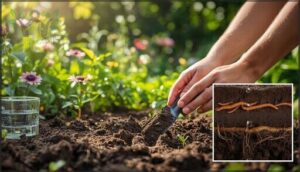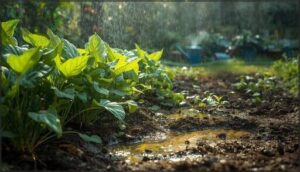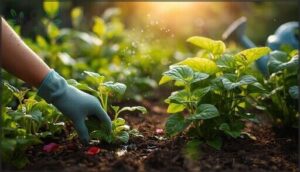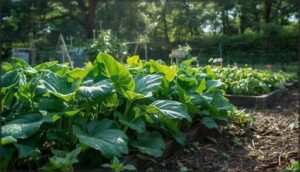This site is supported by our readers. We may earn a commission, at no cost to you, if you purchase through links.
You’d think a little extra water would help your summer garden thrive, but the truth is, overwatering quietly claims more plants than drought ever will. Imagine this: your tomato vines look limp and yellow, soil still damp from yesterday’s generous soak.
It’s a common trap—roots suffocate, leaves drop, and fungal patches creep across the soil before you realize what’s wrong. Recognizing the signs of overwatering in a summer garden takes a sharp eye and a bit of horticultural know-how.
Once you spot the early warnings, you can restore balance and keep your plants vigorous through the hottest months.
Table Of Contents
- Key Takeaways
- Key Signs of Overwatering in Summer Gardens
- Differentiating Overwatering From Underwatering
- How Overwatering Impacts Plant Health
- Checking Soil Moisture Levels Accurately
- Common Causes of Overwatering in Summer
- Assessing Your Watering Routine
- Improving Drainage to Prevent Overwatering
- Reviving Overwatered Garden Plants
- Long-Term Strategies for a Healthy Garden
- Frequently Asked Questions (FAQs)
- Conclusion
Key Takeaways
- Overwatering causes limp, yellowing leaves and mushy stems even when soil feels wet, often leading to root rot and fungal patches.
- Persistent soggy soil and visible mold or fungal growth signal poor drainage and create ideal conditions for pests and diseases.
- Using moisture meters, finger tests, and visual soil checks helps you avoid watering mistakes and respond to your plants’ real needs.
- Improving drainage with well-draining soil, organic amendments, and pots with holes protects roots and keeps your summer garden healthy.
Key Signs of Overwatering in Summer Gardens
Overwatering is one of those mistakes that sneaks up on you, especially during summer when you’re trying to keep everything hydrated. The signs aren’t always obvious at first, but once you know what to look for, they’re hard to miss.
Here are the key indicators that your garden might be getting too much water.
Wilting Leaves Despite Moist Soil
Wilting leaves don’t always mean your plants need water—they might be drowning. When soil moisture stays consistently high, root dysfunction sets in as waterlogged conditions strangle oxygen supply.
Poor soil aeration disrupts water uptake, leaving roots unable to maintain proper leaf turgor despite wet soil. This stress weakens plant respiration and opens the door to root rot if you don’t adjust moisture levels quickly.
Understanding heat stress signs is vital to addressing the issue promptly.
Yellowing and Dropping Leaves
Root dysfunction from overwatering doesn’t stop at wilting leaves—it triggers yellowing and dropping leaves as waterlogged roots choke on depleted soil aeration. You’ll notice soft, limp yellow foliage as root respiration fails and nutrient deficits set in. One potential cause is nutrient deficiency, which can be exacerbated by overwatering.
Watch for these warning signs:
- Yellow leaves starting near the plant base
- Leaf edema forming water-soaked blisters
- Premature bud drop alongside foliage loss
- Unopened leaves falling without drying
- Progressive color loss spreading upward
This cascade signals root rot taking hold.
Mushy or Soft Stems and Leaves
Beyond yellowing foliage, you’ll spot stem softening and mushy leaves—telltale signs of cellular damage from root suffocation. Overwatered tissues swell beyond capacity, developing leaf edema with water-soaked blisters that progress to corky patches. Gentle pressure reveals limp stems that bend or collapse easily, signaling vascular breakdown.
This mushiness often coincides with yellowing leaves and fungal infections, as waterlogged conditions trigger root rot and invite pathogens to attack weakened stem tissue.
Mold or Fungal Growth on Soil
That fungal fuzz on your soil isn’t just unsightly—it’s a red flag. White or green mold growth signals excess moisture that suffocates roots and invites root rot. You’ll notice these warning signs:
- White, fuzzy patches spreading across the surface
- Green algal films in consistently damp zones
- Mushroom fruiting bodies emerging within 72 hours of saturation
- Foul odors indicating bacterial proliferation
This disrupts soil microbe balance and accelerates fungal spore spread.
Soggy or Waterlogged Soil
When your footprint stays visible for over 30 minutes, you’re witnessing a drainage crisis. Soggy soil signs include that characteristic squishy texture and puddling that won’t clear within two hours.
This waterlogged soil chokes root zone oxygen levels below 2 mg/L—less than a third of what healthy roots need—triggering soil moisture management failures that lead straight to root rot.
Differentiating Overwatering From Underwatering
When your plants start looking stressed, it’s easy to assume they need more water—but sometimes the opposite is true. Overwatered and underwatered plants can show surprisingly similar symptoms, which makes diagnosing the real problem tricky.
Learning to spot the key differences will help you respond correctly and save your garden before things get worse.
Leaf Texture and Color Differences
You’ll spot texture changes right away when you compare overwatered and underwatered leaves. Overwatered foliage feels soft and limp—almost mushy—with yellowing that starts at the base and spreads upward evenly. Look for leaf edema, those water-soaked blisters that form when cells burst.
Meanwhile, underwatered leaves turn crispy and brown, with a papery texture. Vein discoloration and color fading signal roots drowning below.
Recognizing Wilting Patterns
Wilting symptoms tell a clear story when you know what to watch for. Overwatered plants droop even with soil saturation above 40%, while underwatered specimens perk up within hours after irrigation.
You’ll notice persistent wilting despite moist conditions—that’s root damage from waterlogged roots cutting off oxygen.
Heat-stress wilting resolves by evening, but water logging keeps leaves limp around the clock, often with yellowing leaves and root rot developing below.
How Overwatering Impacts Plant Health
When you overwater your garden, you’re not just giving plants a little extra drink—you’re setting off a chain reaction that compromises their entire system. The damage starts underground and works its way up, affecting everything from root structure to overall vigor.
Overwatering your garden triggers a hidden chain reaction, silently undermining root health and plant vigor from the ground up
Let’s look at the three major ways overwatering undermines plant health and why catching it early matters.
Root Rot and Root Damage
Root rot and root damage represent the most destructive consequences of overwatering your garden. When roots sit in waterlogged soil, they can’t absorb oxygen—triggering rapid tissue necrosis and creating ideal conditions for fungal infections. You’ll find mushy roots that are dark brown or black instead of firm and white.
This root decay compromises your plant’s entire vascular system, often leading to total collapse if left unchecked.
Nutrient Deficiency and Stunted Growth
Overwatering doesn’t just drown roots—it starves your plants. Saturated soil accelerates nutrient leaching, washing away nitrogen and phosphorus before roots can absorb them. You’ll notice yellowing leaves and growth retardation as essential minerals disappear.
- Nitrogen loss can reach 30% after repeated saturation, causing visible plant malnutrition
- Fertilizer efficiency drops dramatically in waterlogged conditions, wasting your amendments
- Calcium uptake plummets by 60–80% during critical growth stages, hampering fruit development
This nutrient deficiency compounds root health problems, creating a downward spiral.
Increased Susceptibility to Pests and Diseases
Weakened plants become magnets for trouble. Your saturated garden can see fungal infections spike by 70% and pest attraction nearly triple as fungal gnats colonize damp soil.
Root damage from oxygen deprivation slashes your plants’ immune response by 55%, leaving them defenseless against bacterial diseases and soil pathogens.
Aphid outbreaks jump 40% while termite activity climbs 35%—pest control becomes an uphill battle when roots can’t breathe.
Checking Soil Moisture Levels Accurately
Knowing when to water starts with understanding what’s actually happening below the surface. You can’t rely on guesswork or a rigid schedule—your soil will tell you what it needs if you know how to check.
Here are three reliable methods to assess moisture levels and keep your plants thriving.
Using a Moisture Meter
For precision you can count on, a moisture meter takes the guesswork out of watering. High-quality meters can measure soil moisture to within 0.1% accuracy when calibrated for your soil type.
Insert the probe near plant roots at multiple depths, clean it between tests, and follow usage protocols carefully.
Studies show gardeners using meters reduce overwatering by 20–30%, improving plant health and water conservation considerably.
The Finger Test Technique
While meters offer exactness, your fingertip provides instant garden hydration feedback at no cost. Push your index finger 2–3 inches into the soil near plant roots to assess moisture levels through tactile assessment. Here’s what you’ll feel:
- Dry or minimal residue means it’s time to water
- Cool, adhering soil signals adequate moisture
- Soggy, sticky texture indicates overwatering risk
- Rotate testing spots to catch microclimates
Well-practiced gardeners achieve finger test accuracy within 10% of actual readings, helping prevent overwatering in two-thirds of monitored plots.
Visual and Tactile Soil Assessment
Beyond the finger test, you’ll want to examine soil texture and surface appearance for a complete moisture picture. Well-draining soil crumbles easily when pinched, while waterlogged ground forms sticky clumps or sheets.
Look for dark, damp patches, surface pooling, or a plastic consistency—all visual inspection techniques pointing to poor drainage.
Nearly 80% of overwatered soils fail this simple friability test, making tactile assessment methods invaluable for preventing root damage.
Common Causes of Overwatering in Summer
Even with the best intentions, summer watering can go wrong fast. You might think you’re helping your plants thrive, but certain habits and conditions set the stage for overwatering without you realizing it.
Let’s look at the main culprits behind too much moisture in your summer garden.
Watering Frequency Mistakes
You might think watering daily shows good care, but that routine could be sabotaging your summer garden. Over 60% of new gardeners use the same watering schedules for all plants, ignoring species-specific needs—and drought-tolerant varieties are 40% more likely to develop root rot when treated like tropical plants.
Inconsistent watering creates a cycle of stress, increasing root problems by 22% and leaving your garden vulnerable to pests and disease.
Poor Soil Drainage
Even well-draining soil can betray you when compaction takes hold—just four passes of foot traffic reduces water movement by up to 90%.
Clay-heavy beds often drain at less than 0.5 inches per hour, creating waterlogging that suffocates roots within hours.
Without drainage holes in containers or organic amendments improving soil aeration, your garden becomes a swamp where root suffocation replaces healthy growth.
Climate and Environmental Factors
When temperature fluctuations push soil above 85°F, your roots suffocate faster despite increased watering efforts. Humidity levels over 70% slow evaporation rates and trap moisture, while rainfall patterns exceeding 2 inches leach nutrients and flood beds.
Wind impact and soil microclimates created by garden structures complicate matters further—shaded areas retain 22% more saturation, turning well-intentioned watering into environmental factors affecting plants that drown rather than nourish.
Assessing Your Watering Routine
Getting your watering routine right is like finding the sweet spot between too much and too little—it takes observation and a willingness to adjust. You can’t rely on guesswork or a rigid schedule that doesn’t account for what’s actually happening in your garden.
Let’s look at the key factors that’ll help you water smarter, not harder.
Setting an Optimal Watering Schedule
Think of your garden’s watering schedule as a well-tuned clock—consistent intervals keep plant hydration steady without waste. For most summer vegetables, aim for about 1 inch of water weekly, delivered in the morning for best irrigation timing.
Regularly assess soil moisture and adjust watering frequency to match plant needs, promoting water conservation and healthy growth across every bed.
Adjusting for Rainfall and Temperature
Rainfall Tracking and Temperature Effects are game-changers for your watering routine. Sudden storms can saturate soil, while heat waves spike evaporation. Use weather adjustments—like rain gauges or forecasts—to avoid overwatering.
Climate variability demands you stay nimble, checking soil moisture before each watering. This habit ensures healthy drainage and fosters understanding plant water needs, helping you adjust watering habits wisely.
Recognizing Plant-Specific Water Needs
Ever wonder why your basil wilts while your rosemary thrives? Understanding plant water needs starts with knowing Root Depth Variations and Water Absorption Rates.
Herbs, succulents, and shrubs each have unique Plant Hydration Needs—your watering routine must reflect these differences.
Checking Soil Moisture Levels before watering ensures moisture levels support plant health, helping you tailor Watering Schedules for lasting garden vitality.
Improving Drainage to Prevent Overwatering
Good drainage is the backbone of a healthy summer garden. Without it, your plants can quickly become stressed and waterlogged.
Here are a few practical ways you can improve drainage and protect your garden from overwatering.
Choosing Well-Draining Soil Mixes
Is your soil acting more like a sponge than a sieve? Building a well-draining soil mix is essential. Blend screened topsoil, compost, and drainage materials like perlite or coarse sand.
Organic amendments improve soil structure and water retention, while aeration materials boost soil drainage. This combination keeps moisture levels balanced, protecting roots and supporting healthy, resilient summer gardens.
Using Pots With Drainage Holes
Once you’ve built a well-draining soil mix, don’t overlook your containers. Pots with proper drainage holes—matched to the right Drainage Hole Size—keep roots safe from standing water.
Pot Material Matters too; clay breathes better than plastic.
Pairing drainage holes with Water Collection Systems and simple Aeration Techniques helps prevent overwatering, soil erosion, and keeps your summer garden thriving.
Amending Soil With Organic Matter
If your pots drain well but the garden beds still hold water, organic matter is your next ally. Adding compost or mulch boosts Soil Structure Improvement, enhances drainage, and aids Nutent Cycling. Organic Matter Benefits go further—supporting Carbon Sequestration and keeping roots oxygenated. Try these amendments for better results:
- Compost application
- Leaf mold
- Worm castings
- Mulch layering
- Biochar
Reviving Overwatered Garden Plants
If your garden is showing signs of overwatering, there are practical steps you can take to help your plants recover. Acting quickly makes a real difference in restoring their health. Here’s what you’ll want to focus on first.
Pruning Damaged Roots and Leaves
Reach for your secateurs and start with a careful Damage Assessment—prune damaged roots that look mushy or dark to halt Root Rot. Leaf Removal and Stem Trimming target Dropping Leaves, Wilting, and Fungal Growth. These Recovery Techniques redirect energy to healthy growth, setting the stage for a thriving plant.
| Task | Signs to Address | Recovery Benefit |
|---|---|---|
| Root Pruning | Root Rot, mushiness | Improved nutrient flow |
| Leaf Removal | Dropping Leaves | Reduced disease spread |
| Stem Trimming | Wilting, fungus | Enhanced air circulation |
Repotting or Transplanting Techniques
Once you’ve finished Root Pruning, it’s time to Repot the Plant or Transplant. Choose Pot Selection wisely—go for containers 1.5–2 times larger, with multiple Drainage Holes. Use WellDraining Soil Mixing to support recovery and reduce waterlogging.
Transplant Timing matters; aim for mid-spring or early summer. Careful Water Management after repotting prevents renewed stress and encourages strong root establishment.
Treating Fungal Infections and Root Rot
Dealing with Fungal Disease and Root Rot starts with swift action—remove mushy roots, discard infected soil, and improve airflow.
For Plant Recovery, apply a targeted Fungicide Treatment, especially if you spot Fungal Growth or fungus gnats.
Soil Remediation is key; replace overly Moist Soil with a well-draining mix. This approach helps halt Overwatering damage and fosters long-term plant resilience.
Long-Term Strategies for a Healthy Garden
Building a resilient garden means looking beyond quick fixes and focusing on lasting habits. If you’re ready to keep your plants thriving season after season, a few smart changes can make all the difference.
Here are some strategies you can put to work for healthier growth year-round.
Implementing Drip Irrigation Systems
Ever wonder how to water smarter, not harder? A drip irrigation system puts you in control, delivering water right to the root zone with exceptional water efficiency.
Pairing Drip System Design with Irrigation Controllers and Soil Moisture Sensors means automated watering that prevents overwatering and drainage issues.
Your soil stays consistently moist—never soggy—so plant health thrives all summer.
Regular Monitoring and Adjustments
Consistently checking soil moisture levels—whether with Soil Moisture Sensors or the finger test—lets you fine-tune watering schedules and respond to environmental feedback. Adjusting watering habits and improving drainage keep roots healthy and prevent root rot.
Smart Irrigation Management and Garden Automation make routine assessment easy, so your garden thrives through every season, not just in the heat of summer.
Educating Yourself on Plant Water Needs
Understanding your plants is like learning a new language—each species, soil type, and growth stage has its own rhythm. Plant-specific research helps you match watering routines to real needs, while climate considerations and proper drainage prevent waterlogged roots.
When you tune into moisture levels and adjust plant care as conditions shift, your garden responds with steady, healthy growth.
Frequently Asked Questions (FAQs)
Can overwatering attract mosquitoes or other insects?
Picture your garden as a five-star mosquito hotel—overwatering creates standing water risks that lure pests, fungus gnats, and mosquitoes.
Soggy soil and fungal growth transform your yard into prime mosquito breeding grounds and increase insect attraction factors.
What are signs of overwatering in container gardens?
In container gardens, signs of overwatering include waterlogged roots, mushy stems, leaf edema, yellowing or dropping leaves, persistent moist soil, fungal growth on the surface, root decay, and soil erosion—each revealing plant stress and compromised health.
Does overwatering affect flowering or fruit production?
Like a rain-soaked sponge that can’t hold its shape, overwatering triggers Flower Damage and Fruit Reduction. This occurs by causing Water Stress, Root Injury, and nutrient deficiencies—ultimately stunting plant growth, encouraging fungal growth, and leading to overall Plant Decline.
How does mulch influence soil moisture retention?
Mulch benefits your garden by slowing soil moisture loss, boosting water retention, and improving soil condition. Using mulch wisely—whether compost, straw, or wood chips—keeps moisture levels steady and fosters healthy roots, especially in summer’s heat.
Are certain summer vegetables more prone to overwatering?
Absolutely—cucumbers, onions, peppers, summer squash, and beans are especially prone to overwatering. Their Vegetable Sensitivity means Waterlogged Soil quickly triggers root rot, leaf drop, and Summer Crop Risks. Smart Garden Water Management and Overwatering Prevention keep them thriving.
Conclusion
It’s ironic—sometimes the best way to nurture your summer garden is by holding back. Spotting signs of overwatering summer garden plants means you’re not just rescuing roots; you’re sharpening your instincts as a gardener.
Trust your senses, let the soil guide your watering hand, and remember: thriving plants owe as much to restraint as they do to care. When you balance moisture and vigilance, your garden becomes resilient, rewarding you with vibrant growth through the toughest heat.
- https://carpathen.com/blogs/news/signs-of-overwatering-plants-how-to-identify-and-fix-overwatered-plants
- https://foodgardening.mequoda.com/daily/watering-irrigation/how-to-identify-an-overwatered-plant/
- https://www.youtube.com/watch?v=MTKhBCHrHGE
- https://www.mars-hydro.com/info/post/signs-of-overwatering
- https://www.reddit.com/r/botany/comments/rrmrm6/root_rot_from_overwatering_can_someone_explain/

















